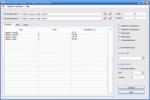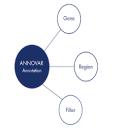Gene Set Enrichment Analysis (GSEA) is a computational method that determines whether an a priori defined set of genes shows statistically significant, concordant differences between two biological states (e.g. phenotypes).
...continue to read
Add to my favorites
Remove from my favorites
The JBrowse Genome Browser
Category: Gene expression, Genomics software
JBrowse is a fast and full-featured scalable genome browser built completely with JavaScript and HTML5. It can run on your desktop, or be embedded in your website (see Bues et al., Genome Biol 17, 66 (2016) doi:10.1186/s13059-016-0924-1).
...continue to readThe Exomiser is a Java applicationthat that finds potential disease-causing variants from whole-exome or whole-genome sequencing data. It is an opensource Java software package that can be downloaded and run on a single desktop computer. It filters and prioritizes candidate genes and variants from whole-exome or wholegenome sequencing data, with a special focus on phenotypic data. Users enter a patient’s clinical features and exome into the program, and Exomiser generates a scored list of cand
...continue to readProDeGe is the first fully automated computational protocol for decontamination of genomes. The protocol uses public databases to detect contamination in agenome assembly, then groups contigs into “Clean” or “Contaminant” groups. ProDeGe spits out lists that users can read through to identify contaminants and determine what they mightbe.The standalone software is freely available and can be run on any system that has Perl, R, Prodigal and NCBI Blast installed. (Tennessen et al., ISME J.
...continue to readPLINK is a popular and computationally efficient software program that offers a comprehensive and well-documented set of automated genome wide association quality control and analysis tools. It is a freely available open source software written in C++, which can be installed on Windows, Mac and Unix machines. The focus of PLINK is purely on analysis of genotype/phenotype data, so there is no support for steps prior to this (e.g. study design and planning, generating genotype or CNV calls from ra
...continue to readPyClone is a tool for inferring the cellular prevalence of point mutations from deeply sequenced data. It serves as a statistical model for inference of clonal population structures in cancers.The model supports simultaneous analysis of multiple related samples and infers clusters of mutations whose cellular prevalences shift together. Such clusters of mutations can be inferred as mutational genotypes of distinct clonal populations (Roth et al., Nature Meth 11, 396, 2014).
...continue to readThe R package multiMiR, with web server is a comprehensive collection of predicted and validated miRNA-target interactions and their associations with diseases and drugs. Within this database, investigators can find clues to potential new treatments for various diseases, including cancer. In addition to helping researchers search for relationships between microRNAs and their genetic targets, multiMiR includes drugs that affect these microRNAs and lists associated diseases.The database combines n
...continue to readThe Bionimbus Protected Data Cloud (PDC), developed at the University of Chicago, is an open-source cloud-based infrastructure for managing, analyzing, and sharing large amounts of genomics and phenotypic data in a secure and compliant manner. Bionimbus is part of a larger project called the Open Science Data Cloud (OSDC) and there is a version of Bionimbus (Bionimbus Community Cloud) for open-access data and a version for controlled-access data (Bionimbus PDC). Bionimbus is based primarily upon
...continue to readBioconductor provides tools for the analysis and comprehension of high-throughput genomic data. Bioconductor uses the R statistical programming language and most bioconductor components are distributed as R packages, which are add-on modules for R. It is open source and open development. Boconductor core team is based primarily at the Fred Hutchinson Cancer Research Center (http://en.wikipedia.org/wiki/Bioconductor)
...continue to read
Add to my favorites
Remove from my favorites
useful and fast genetic calculator
Category: Genomics software



















